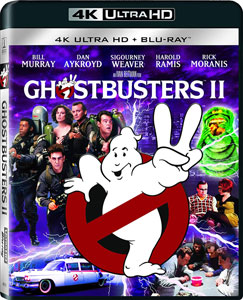“Ghostbusters II” (1989), which feels even more Eighties than the 1984 original, is a prime example of one of those old-school blockbuster sequels that’s defined as much by the fact of its existence as it is by the continuation of the story.
Today, everything is nostalgic, and we can find fans of all but the most obscure stuff online. Thirty years ago, an entertainment property was either “in” or “out,” and “Ghostbusters II” seems consciously aware that it’s “out” and weaves that reality into the fictional narrative.
Out of business
In the way blockbuster sequels used to do it – before sagas such as the Marvel Cinematic Universe developed a TV-style tight serial – “Ghostbusters II” (again directed by Ivan Reitman) starts by catching us up on the big things we missed between movies.

“Ghostbusters II” (1989)
Director: Ivan Reitman
Writers: Dan Aykroyd, Harold Ramis
Stars: Bill Murray, Dan Aykroyd, Sigourney Weaver
Despite the goodwill at the end of movie one, the Ghostbusters have gone out of business thanks to being sued by government entities at every level. And Venkman (Bill Murray) and Dana (Sigourney Weaver) have split up so the writers – again Dan Aykroyd and Harold Ramis – can bring them back together again over the course of the sequel.
In a rare example of meta storytelling before that approach went mainstream, Ray (Aykroyd) and Winston (Ernie Hudson) take a birthday party gig, but when they ask the kids “Who you gonna call?,” the kids say “He-Man!” The filmmakers go ahead and make the iconic-but-kind-of-annoying theme song part of the fictional world here, too, as Ray and Winston play it on a boombox.
A less-nuanced blend
Although the sequel blends comedy, government critiques and horror imagery like the original, it’s not as nuanced. The jokes aren’t as funny, the commentary is broader and the images aren’t as scary.
Unless, that is, you’re a new parent. Dana’s baby, Oscar, rolls into traffic in his buggy, is lured onto a high-rise ledge, is nabbed by the evil demon Vigo (Wilhelm von Homburg), and perhaps scariest of all, sleeps on his stomach (in a time before the medical establishment realized it’s dangerous). “Ghostbusters II” is an endless nightmare for parents of a baby.
Peter MacNicol desperately tries to add some spice as Janosz Poha, giving a proto-Borat turn as the museum curator awkwardly crushes on his employee Dana and is pulled under the thrall of Vigo, whose spirit lives in a painting. But there’s no suspense or mystery to this narrative because we see right off the bat that Vigo lives in the painting; then it’s just a matter of waiting till he gets out.
One B-storyline that’s kind of appealing is the unexpected romance between Ghostbusters secretary Janine (Annie Potts) and lawyer Louis (Rick Moranis). It comes out of nowhere, as the first film established that Janine likes Spengler (Ramis), but it’s kind of cute, and a nice bone to throw to neurotic people who can relate to Louis.

The best humor comes early on, like when Spengler is running experiments and is so involved in the science that he doesn’t care about the subjects. Measuring the effect of a person’s negative emotions on the surrounding molecules, he tells Dana that Venkman never asks about her, then quickly raises his instrument for a measurement.
Seeking positive vibes
The negative collective consciousness in New York City indeed leads to the rise of Vigo, who can only be defeated by positive vibes. This isn’t a bad notion – and the river of pink negative-energy slime running underneath the city is creepy-cool — but the execution gets clunky as “Ghostbusters II” progresses.
This is one of those sequels where a viewer feels the creative team’s energy waning. Inexplicably (maybe it’s in a deleted scene), the Ghostbusters rig their devices to store and spew positive-energy slime.
They cover the Statue of Liberty in the slime, and it magically walks through the city to the museum. Granted, the first film also ends with a “Hey, look at this special effect!” sequence (the Stay-Puft Marshmallow Man), but the Statue of Liberty sequence is more random.
I tried to take the theme to heart and keep up my positive energy about “Ghostbusters II,” but – while I enjoyed having another adventure with the gang — it’s clearly inferior to the classic original.
By 1989, the Ghostbusters were “out” on the pop-culture meter, and this sequel did exactly what sequels were expected to do: It made half of the original film’s box-office take by stirring memories of its greatness, then politely retreated. Tim Burton’s “Batman” came out one week later.

